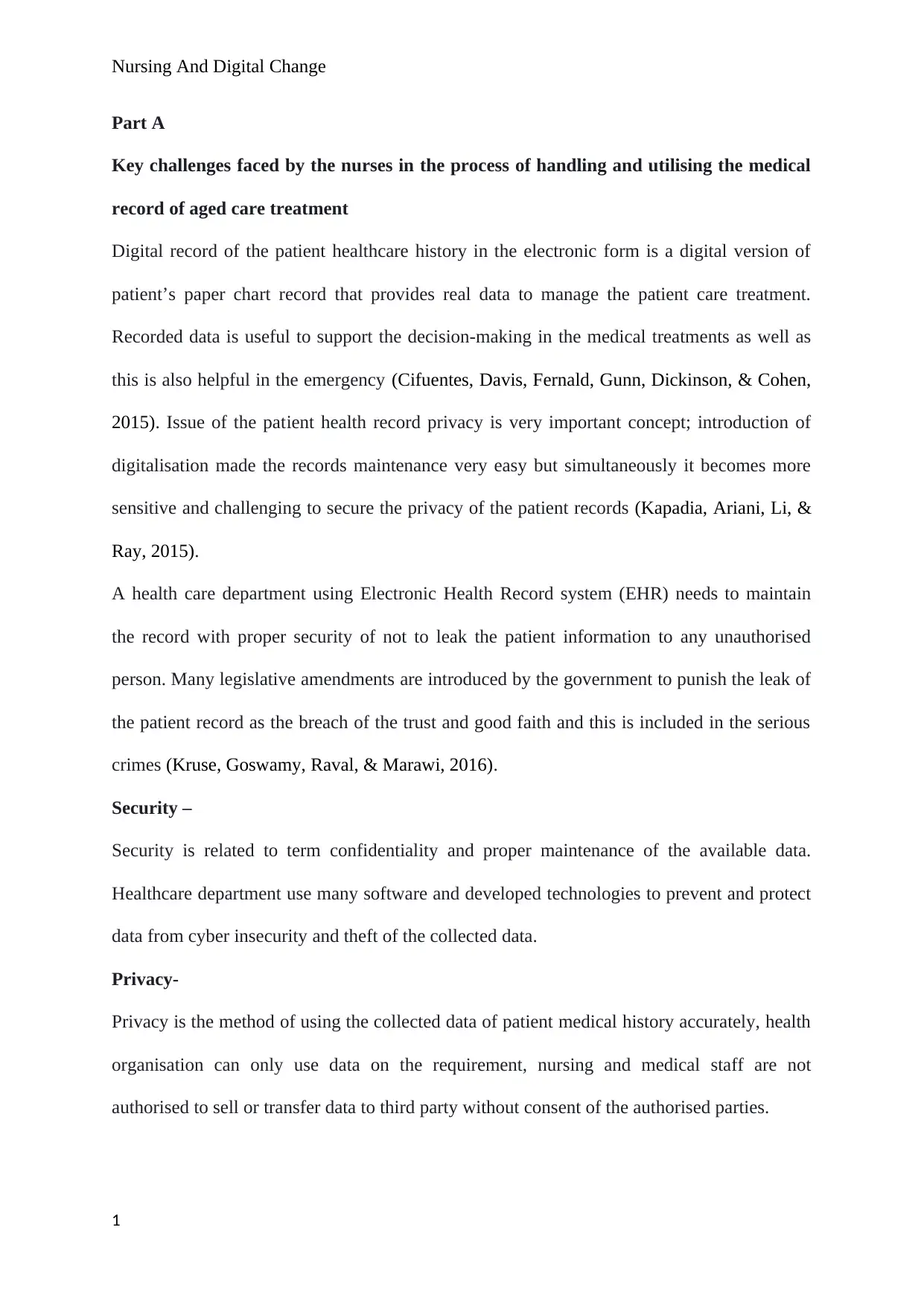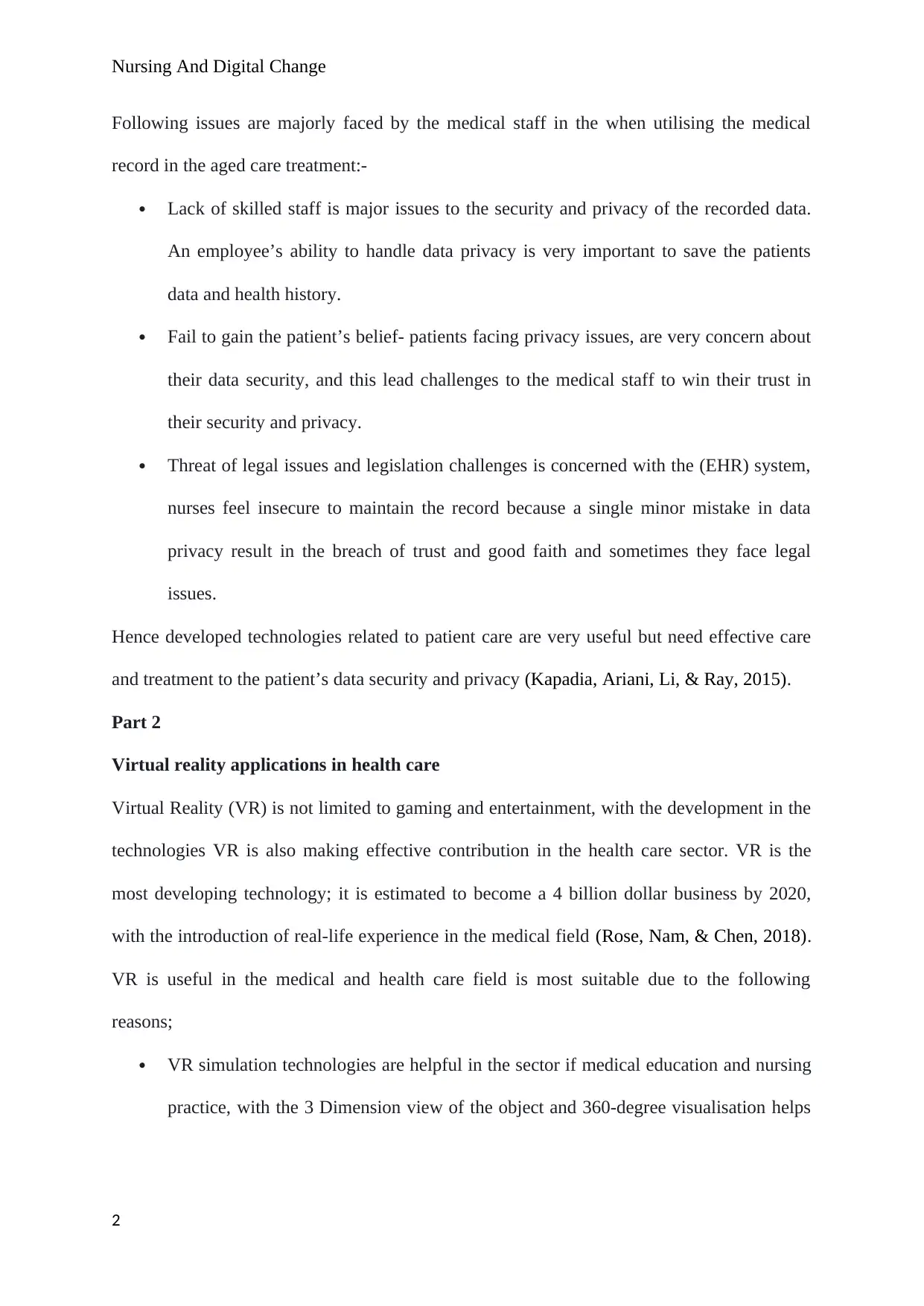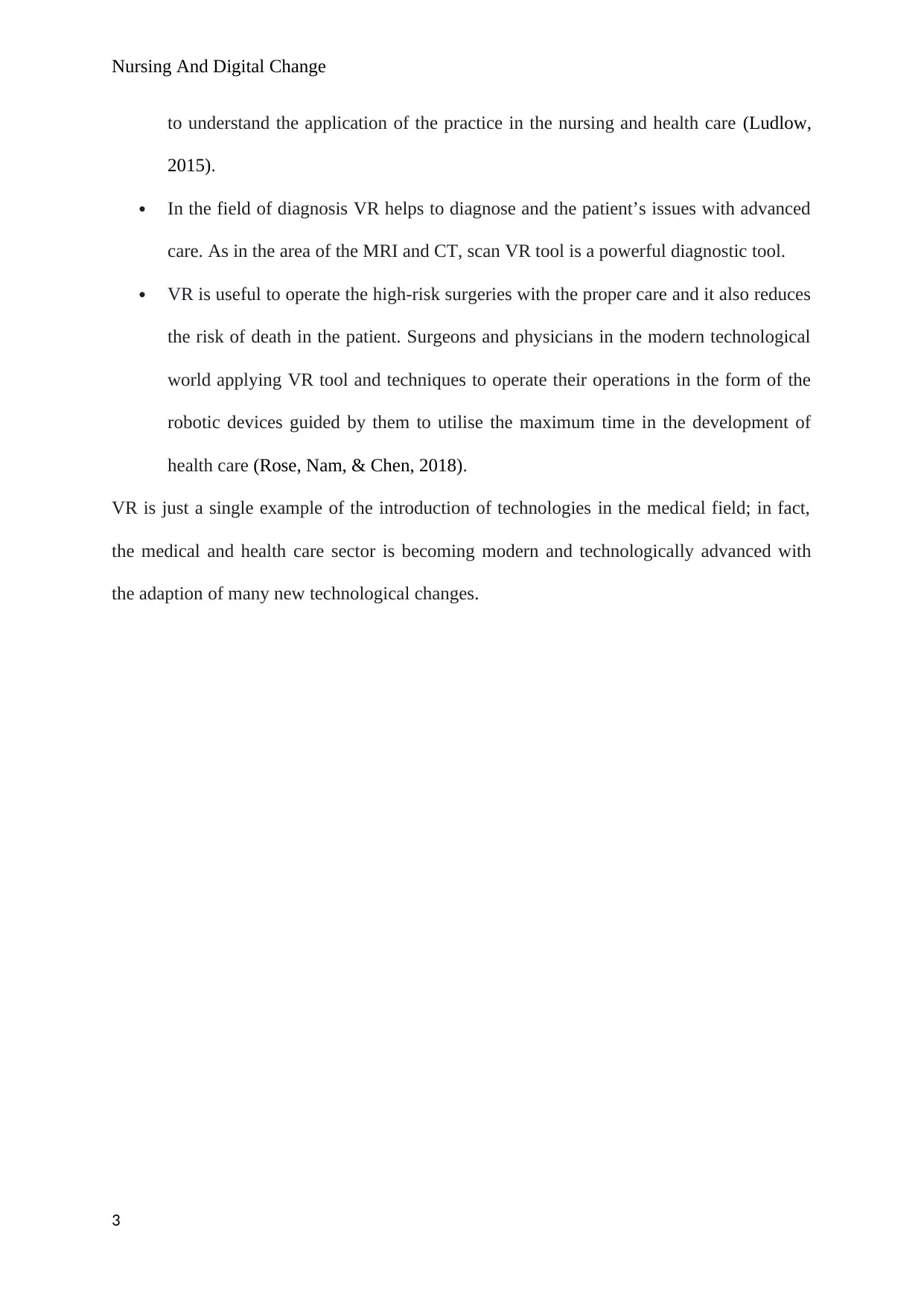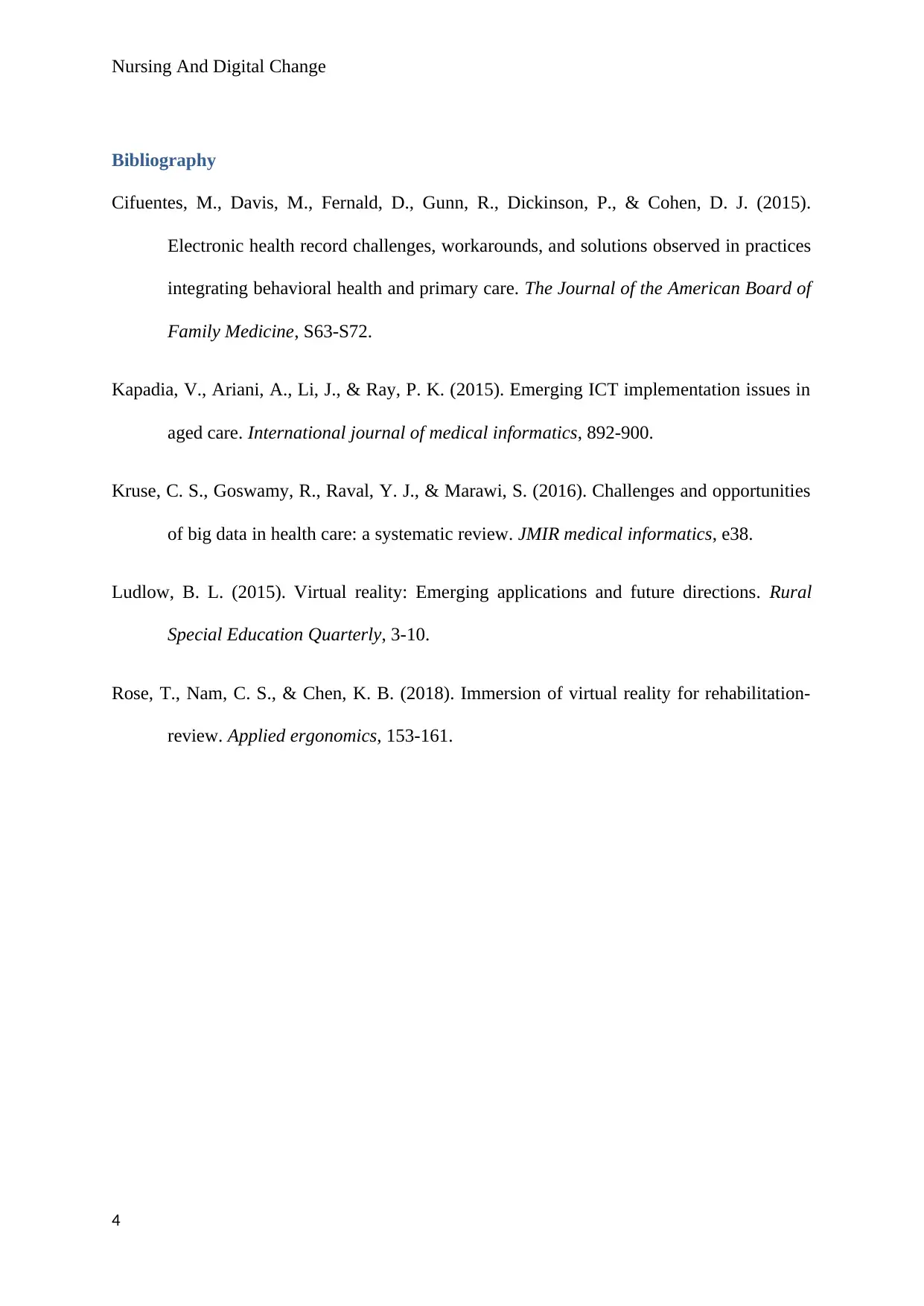HSC210: Nursing and Digital Change - Aged Care, VR, and Healthcare
VerifiedAdded on 2022/09/28
|4
|991
|18
Report
AI Summary
This report, focusing on the impact of digital transformation in nursing, delves into the challenges faced by nurses in utilizing electronic health records (EHRs) within aged care settings, particularly concerning patient privacy and data security. It highlights the lack of skilled staff and the need to build patient trust in the digital environment. The report then explores the application of virtual reality (VR) in healthcare, emphasizing its potential in medical education, diagnostics (e.g., MRI and CT scans), surgery, and rehabilitation. The benefits of VR include enhanced visualization, simulation of real-life scenarios, and the potential to improve patient outcomes. The report references key studies to support its arguments, providing a comprehensive overview of the current state and future possibilities of technology in nursing and healthcare.

Nursing And Digital Change
Part A
Key challenges faced by the nurses in the process of handling and utilising the medical
record of aged care treatment
Digital record of the patient healthcare history in the electronic form is a digital version of
patient’s paper chart record that provides real data to manage the patient care treatment.
Recorded data is useful to support the decision-making in the medical treatments as well as
this is also helpful in the emergency (Cifuentes, Davis, Fernald, Gunn, Dickinson, & Cohen,
2015). Issue of the patient health record privacy is very important concept; introduction of
digitalisation made the records maintenance very easy but simultaneously it becomes more
sensitive and challenging to secure the privacy of the patient records (Kapadia, Ariani, Li, &
Ray, 2015).
A health care department using Electronic Health Record system (EHR) needs to maintain
the record with proper security of not to leak the patient information to any unauthorised
person. Many legislative amendments are introduced by the government to punish the leak of
the patient record as the breach of the trust and good faith and this is included in the serious
crimes (Kruse, Goswamy, Raval, & Marawi, 2016).
Security –
Security is related to term confidentiality and proper maintenance of the available data.
Healthcare department use many software and developed technologies to prevent and protect
data from cyber insecurity and theft of the collected data.
Privacy-
Privacy is the method of using the collected data of patient medical history accurately, health
organisation can only use data on the requirement, nursing and medical staff are not
authorised to sell or transfer data to third party without consent of the authorised parties.
1
Part A
Key challenges faced by the nurses in the process of handling and utilising the medical
record of aged care treatment
Digital record of the patient healthcare history in the electronic form is a digital version of
patient’s paper chart record that provides real data to manage the patient care treatment.
Recorded data is useful to support the decision-making in the medical treatments as well as
this is also helpful in the emergency (Cifuentes, Davis, Fernald, Gunn, Dickinson, & Cohen,
2015). Issue of the patient health record privacy is very important concept; introduction of
digitalisation made the records maintenance very easy but simultaneously it becomes more
sensitive and challenging to secure the privacy of the patient records (Kapadia, Ariani, Li, &
Ray, 2015).
A health care department using Electronic Health Record system (EHR) needs to maintain
the record with proper security of not to leak the patient information to any unauthorised
person. Many legislative amendments are introduced by the government to punish the leak of
the patient record as the breach of the trust and good faith and this is included in the serious
crimes (Kruse, Goswamy, Raval, & Marawi, 2016).
Security –
Security is related to term confidentiality and proper maintenance of the available data.
Healthcare department use many software and developed technologies to prevent and protect
data from cyber insecurity and theft of the collected data.
Privacy-
Privacy is the method of using the collected data of patient medical history accurately, health
organisation can only use data on the requirement, nursing and medical staff are not
authorised to sell or transfer data to third party without consent of the authorised parties.
1
Paraphrase This Document
Need a fresh take? Get an instant paraphrase of this document with our AI Paraphraser

Nursing And Digital Change
Following issues are majorly faced by the medical staff in the when utilising the medical
record in the aged care treatment:-
Lack of skilled staff is major issues to the security and privacy of the recorded data.
An employee’s ability to handle data privacy is very important to save the patients
data and health history.
Fail to gain the patient’s belief- patients facing privacy issues, are very concern about
their data security, and this lead challenges to the medical staff to win their trust in
their security and privacy.
Threat of legal issues and legislation challenges is concerned with the (EHR) system,
nurses feel insecure to maintain the record because a single minor mistake in data
privacy result in the breach of trust and good faith and sometimes they face legal
issues.
Hence developed technologies related to patient care are very useful but need effective care
and treatment to the patient’s data security and privacy (Kapadia, Ariani, Li, & Ray, 2015).
Part 2
Virtual reality applications in health care
Virtual Reality (VR) is not limited to gaming and entertainment, with the development in the
technologies VR is also making effective contribution in the health care sector. VR is the
most developing technology; it is estimated to become a 4 billion dollar business by 2020,
with the introduction of real-life experience in the medical field (Rose, Nam, & Chen, 2018).
VR is useful in the medical and health care field is most suitable due to the following
reasons;
VR simulation technologies are helpful in the sector if medical education and nursing
practice, with the 3 Dimension view of the object and 360-degree visualisation helps
2
Following issues are majorly faced by the medical staff in the when utilising the medical
record in the aged care treatment:-
Lack of skilled staff is major issues to the security and privacy of the recorded data.
An employee’s ability to handle data privacy is very important to save the patients
data and health history.
Fail to gain the patient’s belief- patients facing privacy issues, are very concern about
their data security, and this lead challenges to the medical staff to win their trust in
their security and privacy.
Threat of legal issues and legislation challenges is concerned with the (EHR) system,
nurses feel insecure to maintain the record because a single minor mistake in data
privacy result in the breach of trust and good faith and sometimes they face legal
issues.
Hence developed technologies related to patient care are very useful but need effective care
and treatment to the patient’s data security and privacy (Kapadia, Ariani, Li, & Ray, 2015).
Part 2
Virtual reality applications in health care
Virtual Reality (VR) is not limited to gaming and entertainment, with the development in the
technologies VR is also making effective contribution in the health care sector. VR is the
most developing technology; it is estimated to become a 4 billion dollar business by 2020,
with the introduction of real-life experience in the medical field (Rose, Nam, & Chen, 2018).
VR is useful in the medical and health care field is most suitable due to the following
reasons;
VR simulation technologies are helpful in the sector if medical education and nursing
practice, with the 3 Dimension view of the object and 360-degree visualisation helps
2

Nursing And Digital Change
to understand the application of the practice in the nursing and health care (Ludlow,
2015).
In the field of diagnosis VR helps to diagnose and the patient’s issues with advanced
care. As in the area of the MRI and CT, scan VR tool is a powerful diagnostic tool.
VR is useful to operate the high-risk surgeries with the proper care and it also reduces
the risk of death in the patient. Surgeons and physicians in the modern technological
world applying VR tool and techniques to operate their operations in the form of the
robotic devices guided by them to utilise the maximum time in the development of
health care (Rose, Nam, & Chen, 2018).
VR is just a single example of the introduction of technologies in the medical field; in fact,
the medical and health care sector is becoming modern and technologically advanced with
the adaption of many new technological changes.
3
to understand the application of the practice in the nursing and health care (Ludlow,
2015).
In the field of diagnosis VR helps to diagnose and the patient’s issues with advanced
care. As in the area of the MRI and CT, scan VR tool is a powerful diagnostic tool.
VR is useful to operate the high-risk surgeries with the proper care and it also reduces
the risk of death in the patient. Surgeons and physicians in the modern technological
world applying VR tool and techniques to operate their operations in the form of the
robotic devices guided by them to utilise the maximum time in the development of
health care (Rose, Nam, & Chen, 2018).
VR is just a single example of the introduction of technologies in the medical field; in fact,
the medical and health care sector is becoming modern and technologically advanced with
the adaption of many new technological changes.
3
⊘ This is a preview!⊘
Do you want full access?
Subscribe today to unlock all pages.

Trusted by 1+ million students worldwide

Nursing And Digital Change
Bibliography
Cifuentes, M., Davis, M., Fernald, D., Gunn, R., Dickinson, P., & Cohen, D. J. (2015).
Electronic health record challenges, workarounds, and solutions observed in practices
integrating behavioral health and primary care. The Journal of the American Board of
Family Medicine, S63-S72.
Kapadia, V., Ariani, A., Li, J., & Ray, P. K. (2015). Emerging ICT implementation issues in
aged care. International journal of medical informatics, 892-900.
Kruse, C. S., Goswamy, R., Raval, Y. J., & Marawi, S. (2016). Challenges and opportunities
of big data in health care: a systematic review. JMIR medical informatics, e38.
Ludlow, B. L. (2015). Virtual reality: Emerging applications and future directions. Rural
Special Education Quarterly, 3-10.
Rose, T., Nam, C. S., & Chen, K. B. (2018). Immersion of virtual reality for rehabilitation-
review. Applied ergonomics, 153-161.
4
Bibliography
Cifuentes, M., Davis, M., Fernald, D., Gunn, R., Dickinson, P., & Cohen, D. J. (2015).
Electronic health record challenges, workarounds, and solutions observed in practices
integrating behavioral health and primary care. The Journal of the American Board of
Family Medicine, S63-S72.
Kapadia, V., Ariani, A., Li, J., & Ray, P. K. (2015). Emerging ICT implementation issues in
aged care. International journal of medical informatics, 892-900.
Kruse, C. S., Goswamy, R., Raval, Y. J., & Marawi, S. (2016). Challenges and opportunities
of big data in health care: a systematic review. JMIR medical informatics, e38.
Ludlow, B. L. (2015). Virtual reality: Emerging applications and future directions. Rural
Special Education Quarterly, 3-10.
Rose, T., Nam, C. S., & Chen, K. B. (2018). Immersion of virtual reality for rehabilitation-
review. Applied ergonomics, 153-161.
4
1 out of 4
Related Documents
Your All-in-One AI-Powered Toolkit for Academic Success.
+13062052269
info@desklib.com
Available 24*7 on WhatsApp / Email
![[object Object]](/_next/static/media/star-bottom.7253800d.svg)
Unlock your academic potential
Copyright © 2020–2025 A2Z Services. All Rights Reserved. Developed and managed by ZUCOL.





